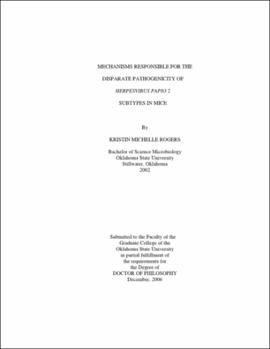| dc.contributor.advisor | Eberle, R. | |
| dc.contributor.author | Rogers, Kristin Michelle | |
| dc.date.accessioned | 2013-11-26T08:35:17Z | |
| dc.date.available | 2013-11-26T08:35:17Z | |
| dc.date.issued | 2006-12 | |
| dc.identifier.uri | https://hdl.handle.net/11244/7671 | |
| dc.description.abstract | Scope and Method of Study: The purpose of this study was to identify viral determinants of the neuropathogenesis or avirulence of Herpesvirus papio 2 subtypes (HVP2nv and HVP2ap) in BALB/c mice. Experiments were conducted to determine if HVP2 subtypes were similar within the natural baboon host. Focus then turned to characterizing the temporal and spatial distribution of HVP2 subtypes within the central nervous system (CNS) of mice following different routes of inoculation. Serum anti-HVP2 IgG levels were measured by ELISA and tissues were examined microscopically with routine stains and immunohistochemistry. HVP2-specific quantitative real-time PCR was used to determine the amount of viral DNA within infected mouse tissues at various times post-infection. Primary mouse dermal fibroblast (PMDF) cell cultures were developed as a model system to examine early host responses to viral infection at the site of inoculation. | |
| dc.description.abstract | Findings and Conclusions: HVP2 subtypes were indistinguishable in the natural baboon host. Experimental HVP2nv infection of mice produced a fulminant, fatal encephalomyelitis for all routes of inoculation tested: intra-muscular, intracerebral, eye splash, and epidermal scarification. Mice infected with HVP2ap in the same manner showed no clinical signs of CNS infection. Minimal HVP2ap replication at the site of inoculation and within the CNS was evidenced by mild, primarily immune-mediated lesions in which viral antigen and viral DNA were conspicuously absent. Only mice that received 106 PFU of HVP2ap developed CNS disease following intra-cerebral inoculation. Thus, HVP2 is neuroinvasive but not neurovirulent. Experiments in PMDF cultures revealed differential responses of HVP2 subtypes to IFN-B : HVP2nv decreases INF-B expression and evades its anti-viral effects while HVP2ap-infected PMDF cells produce appreciable quantities of IFN-B resulting in decreased titers. Differences in the host-virus interactions largely determine the outcome of HVP2 infection in mice. | |
| dc.format | application/pdf | |
| dc.language | en_US | |
| dc.rights | Copyright is held by the author who has granted the Oklahoma State University Library the non-exclusive right to share this material in its institutional repository. Contact Digital Library Services at lib-dls@okstate.edu or 405-744-9161 for the permission policy on the use, reproduction or distribution of this material. | |
| dc.title | Mechanisms responsible for the disparate pathogenicity of Herpesvirus papio 2 subtypes in mice | |
| dc.contributor.committeeMember | Melcher, Ulrich | |
| dc.contributor.committeeMember | d'Offay, Jean | |
| dc.contributor.committeeMember | Saliki, Jeremiah | |
| osu.filename | Rogers_okstate_0664D_2063 | |
| osu.accesstype | Open Access | |
| dc.type.genre | Dissertation | |
| dc.type.material | Text | |
| thesis.degree.discipline | Veterinary Biomedical Science | |
| thesis.degree.grantor | Oklahoma State University | |
